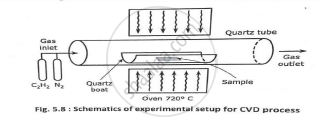Advertisements
Advertisements
Question
Witte the CVD method for preparation of carbon nanotubes.
Solution
This is very good method from large scale production of carbon nanofiber SWNT, MWNT.
Hydrocarbons (e.g., methane, ethane) are allowed to decompose over metal catalyst (e.g., Co,
Fe) to produce CNT. Typical yield for CVD are approximately 30% . This process includes
production of large amount of CNT's by CVD of acetylene over cobalt and iron. Ethylene can be
used with reaction temperatures of 545°C for nickel catalyst CVD and 900°C for an uncata/yzed
process that produces carbon nanostructure with open ends. Methane can also be used as
carbon source for synthesization. catalytic decomposition of H2/CH4 mixture over cobalt,
nickel, and iron is used to obtain yields of SWNTs at 1000°C The usage of H/CH4 atmosphere
between a non-reducible oxide such as Al203 or MgAl2 04 and

one or more transition metal oxides can produce the composite powders containing well
dispersed CNTs. Thus, higher proportion of SWNTs and lower proportion of MWNTs can be
achieved using the decomposition of CH4 over the nanoparticles. Thermal catalytic
decomposition of hydrocarbon has become an active area of research and can be a promising
route for the bulk production of CNTs. The removal of the catalyst support via an acid
treatment which sometimes could destroy the original structure of the carbon nanotube is an
issue in this synthesis route. However, alternative catalyst supports that are soluble in water
have proven effective for nanotube growth.
